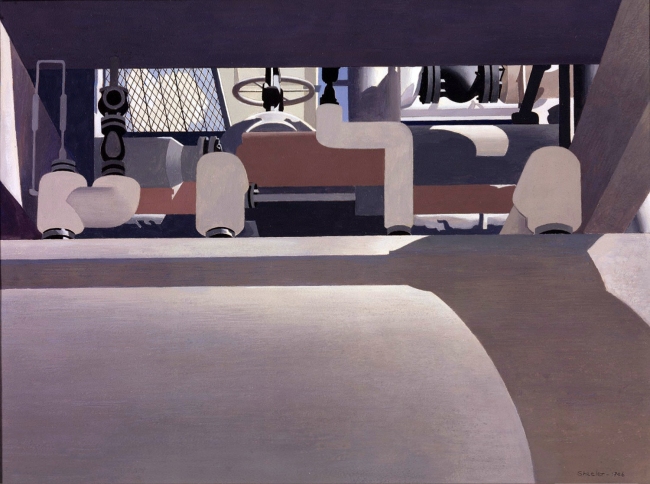This post directly continues a first one on this American artist: “Charles Sheeler – Paintdrawgrapher of factories and machinery (Part I)”.
[You may also read them in Catalan on my blog at VilaWeb.cat: “Charles Sheeler – ‘Pintògraf’ de fàbriques i maquinària (Part I)” & “Charles Sheeler – Del fotorealisme a l’abstracció (Part II)”
–
Around 1945, Sheeler began, quite decidedly, to paint in a less photorealistic style, due to the criticism that his works had been receiving -about being “too coldly” precise and rather “devoid of emotional contents”. This has probably deprived us of wonderful, staggering paintings like so many earlier ones by him truly were, but conversely has let us discover an equally inspired and most interesting body of work.
I have selected ten oils from this last period of increasing abstraction, surprising compositions and passion for geometry; they are dated between 1946 to 1959.
(You will not find comments on the paintings here -like those I wrote in the previous post-, aside of one on “Stacks in Celebration” at the end. Maybe I will add some other in the following days, but I must first get solved the eyesight issues I am having lately. So, I post this more or less as I had it saved as a draft from weeks ago.)
–

–
–

–
–
–

–
–

–
–

–
–

–
–

–
–

–
–
I’ve chosen “Stacks in Celebration” to head this post on Charles Sheeler’s late period because it comes directly from “Fugue” (1940) and, hence, from his earlier photographs of the electric power plant at New Bedford, Massachusetts.
Now, after 14 years, we watch a mix of reality and abstraction (as well as a mix of American and European influences, just as before). Sheeler took several excellent pictures of this plant -as the one I show in my previous post-, and even in his first period, when recreating his photographs into paintings, he changed the framings -and many details- and added shapes that were not there. Here, in this painting, we also see the superposition of at least three different views, and all these triangular rays that inter-cross in the sky focusing on sections of the factory. The colours have become flat; the forms seem to move -or perhaps dance-; the musical “fugue” alluded in the tempera of 1940 is now quite more notoriously represented. By mixing the reality of this American symbol, the factory, with abstract patterns and colours, Sheeler tries to say louder than ever before that his painting, like the factory itself, is a product of inventiveness and creativity -as if it was not already clear in the paintings and drawings from the 30s and early 40s…! – Anyway nobody could say then that he was “copying” reality trough pictures anymore.
- Stacks in Celebration (1954 – oil on canvas, 22 x 28 inches) – The Dayton Art Institute, Ohio.
–
Index, with all data I can provide, of the rest of the works displayed in the post:
- Incantation (1946 – oil on canvas 61.3 x 51.1 cm) – Brooklyn Museum.
- Mechanization (1946 – oil on canvas).
- Against the Sky a Web has Spun (1948 – oil on canvas).
- Ore into Iron (1953 – oil on canvas, 61.3 x 46 cm) – Boston Museum of Fine Arts.
- Stacks in Celebration
- Midwest (1954 – oil on canvas) – Walker Art Centre, Minneapolis.
- The Web (Croton Dam) (1955 – oil on canvas, 56.5 x 61 cm) – Collection Neuberger Museum of Art, New York.
- Golden Gate (1955 – oil on canvas, 63.8 × 86.4 cm) – Metropolitan Museum of Art, New York City.
- Red against White (1957 – oil on canvas) – Boston Museum of Fine Arts.
- Composition around White (1959 – oil on canvas, 76.2 x 83.8 cm) –
–
No unauthorised copying or redistribution. All Rights Reserved.


